Thiel Audio Products CS3.6 User manual
- Category
- Soundbar speakers
- Type
- User manual

OWNER INFORMATION
THIE L
Model CS3.6
Coherent
Source
®
loudspeaker
system
D
E
S
I
G
N
&
E
N
G
I
N
E
E
R
I
N
G
H
O
N
O
R
S
®
INNOVATIONS 93
CONSUMER ELECTRONICS SHOW
1993
AudioVideo
GRAND PRIX
WINNER
of the
from
The professional magazine
of US home electonics
INTERNATIONAL
®
LOUDSPEAKER
of the
YEAR
1993
1995
AudioVideo
GRAND PRIX
WINNER
of the
from
The professional magazine
of US home electonics
INTERNATIONAL

C
ongratulations on your purchase of the THIEL model CS3.6 loudspeaker system. This fine product
is the result of a dedicated effort to provide very accurate music reproduction. We have used very
high quality components and taken great care in the CS3.6’s construction. Properly set up and used
with good associated equipment, the CS3.6 will provide you with a great deal of musical enjoyment for
many years.
SPEAKER PLACEMENT
The CS3.6s are relatively noncritical to room placement and will provide good results from almost anywhere. However, here
are some guidelines to help you achieve the best sound from your speakers. Speaker placement will affect the accuracy of
timbre, spatial performance, and bass performance.
Distance from walls: THIEL speakers, and most others, sound best if they are placed well away from all walls. Such
placement optimizes imaging and depth, and musical timbres are reproduced with the least coloration because it allows the
initial sound coming from the speaker to be distinctly separated in time from the secondary sound of wall reflections. If
reflections are heard too quickly after the primary sound, your brain tends to interpret them as part of the initial sound,
causing the perceived timbre to be altered and the spatial characteristics to be confused.
If you experiment, you will notice a major improvement in openness when the speakers are even two feet from the rear wall
instead of one. We like to see the speakers three feet from the rear wall and five feet from the side wall. Also, it is not
desirable for large objects to be placed near the speakers since these will also be a source of unwanted early reflections that
reduce imaging accuracy.
Spacing: Because of their very wide, even dispersion of energy, THIEL speakers should usually be placed farther apart
than most. Optimum imaging is usually achieved when the speakers and the listener form an equilateral triangle, although
this will depend on the width of the room—a narrow room will require closer placement. If the speakers are too far apart for a
given environment, there will tend to be a “hole” in the middle of the sound stage; if they are too close together, the image
will be compressed and will not achieve optimum width.
Aiming: We usually prefer the imaging obtained when the speakers are pointed straight ahead rather than pointing toward
the listener. This placement produces the largest, most natural soundstage. However, toeing the speakers in somewhat may
produce more specific placements of instruments. Also, if it is not possible to get the speakers far enough away from the side
walls, a toed-in position can be helpful to reduce the strength of wall reflections.
Bass: Bass response is also affected by speaker placement. In general, when a speaker is close to a wall the bass response
is stronger and placing a speaker in a corner will make it even more so. In order to achieve properly balanced bass, it is
necessary for the speaker to be used in the environment for which it was designed. THIEL speakers are designed to provide
accurate bass when positioned away from all walls—the same position that provides the best imaging.
Listener position: The CS3.6s provide broad dispersion of energy at all frequencies and therefore provide good results
throughout a large listening area. Best imaging is provided for a listener centered in front of the speakers. Optimum phase
and time alignment is provided only for a seated listener who is eight or more feet away from the speakers.
All aspects of speaker placement are dependent on the particular room. Since every room is different, no hard rules can be
given, and experimentation is necessary to achieve the best results.

Bottom view of cabinet
CONNECTING THE SPEAKERS
The CS3.6’s input terminals are located on the bottom of the
speaker. To gain access to them, the speaker should be laid on
its back or side. Make sure that all connections are tight.
It is essential for proper performance that both speakers in a
stereo system be wired in the same polarity. The speaker’s input
terminals are color coded to facilitate this. The wire connected to
the red input terminal of each speaker should connect to the
respective positive (+) output terminals of the amplifier; the wire
connected to the black input terminals should be connected to the
respective negative (–) output terminals of the amplifier.
The speakers should be connected to the amplifier with high
quality cable to ensure minimal loss of power and proper control
by the amplifier. If the speakers are being connected to a vacuum
tube amplifier with various impedance taps, the 4 ohm tap will
usually give the best results.
Due to European CE regulations that do not permit banana
plug type loudspeaker connections, we ship THIEL speakers
with removable plugs installed in the ends of the binding posts.
If you wish to use banana plug type connections, you may
remove the black plastic plug inserted into the end of each
metal binding post cap. To remove the plug, use your fingernail
to pry along the bottom edge of the plastic insert and lift out.
STABILIZER PINS
The speakers should be positioned before the stabilizer pins are installed.
Speakers positioned on a soft surface such as carpeting are able to rock back and forth slightly and will vibrate in reaction
to those forces the speaker generates to move the driver diaphragms. (Every action has an equal and opposite reaction.) This
motion of the speaker causes a loss of musical information and reduces the clarity of the music.
To eliminate this effect, the THIEL CS3.6 can be used with the provided stabilizer pins. The stabilizer pins are pushed into
three pre-drilled holes in the base under each speaker. The pin point penetrates the carpet and allows the speaker to rest
firmly on the floor. The three pins provide a stable foundation which eliminates some obscuring of information and produces
a cleaner, more articulate sound. No pins are required when placing the speakers on hard or smooth surfaces.
There are some applications where the stabilizer pins will not bring an improvement in sound but may actually make it
worse. This situation occurs when the floor itself is not rigid and therefore vibrates when connected to the speakers via the
stabilizer pins. We encourage you to experiment to determine for yourself whether or not this is the case.
We recommend that you determine the position of your speakers before inserting the pointed stabilizer pins. To insert the
pins, tilt the speaker forward and push the two back pins fully into the 1" deep holes located in each back corner of the base.
Then rock the speaker backward and insert the front pin. Finally, press firmly on the top of the speaker with a slight rocking
motion until the pins penetrate the carpet completely. To check that the pins are firmly seated, lightly tap the back and side of
the speaker. There should be no movement and the speaker should feel solidly in place.
If the speaker is moved with the pins in place, care should be taken to lift the speaker straight upward until all the pins have
cleared the carpet. Also, tilting the speaker so its weight is resting on any single pin can damage the wood base.
Please be cautioned that the pointed pins can be dangerous if not used with care. They can cause small dents in hardwood
floors and it is possible to damage carpets if the speakers are moved incorrectly with the pins in place.
®
MANUFACTURED BY:
THIEL Lexington, Kentucky USA
THIE L
Coherent Source
LOUDSPEAKER
GRILLE SHOULD REMAIN IN PLACE
FOR BEST SONIC PREFORMANCE
MODEL
CS3.6
S/N
Stabilizer Pin Holes
Input Terminals

BREAK-IN
The CS3.6’s, like most speakers, require a period of playing before they perform optimally. The time depends on how loudly
the speakers are played; more time is required if played softly, less if played loudly. At least 50 hours at moderately loud
levels are required before the speaker is performing near optimum. You should notice even more improvement after 100
hours of playing.
ASSOCIATED EQUIPMENT
The CS3.6 is a very high quality sound reproducer and will benefit from use with the best associated equipment. Since it is
extremely accurate, it will reveal sources of distortion generated elsewhere in the system. For example, distortion resulting
from poor recordings or inferior electronics will be reproduced accurately. Also, the quality of the interconnect cables and
speaker cables will significantly effect the performance of the system.
POWER REQUIREMENTS
It is important to have enough power to play at the level you desire without distortion. If high sound levels are desired, the
CS3.6’s are designed to be used with amplifiers rated up to 400 watts per channel (into 4 ohms). If you play the speakers
more loudly than the volume the amplifier can cleanly produce, the amplifier will produce overload (clipping) distortion. The
sound will become compressed, strained, and in extreme cases, obviously distorted. This distortion is actually non-musical
additional energy and since it is concentrated in the high frequency region where the speaker is least able to handle it,
tweeters can be damaged in extreme cases.
Keep in mind that sound quality is usually much more important than sound quantity. There can be large differences in the
sonic performance of two amplifiers of equal power, and this is more important than large differences in power. Most
everyone will be happier with a 100 watt amplifier of high sonic quality than a 200 watt amplifier of mediocre sonic quality.
For this reason, we feel there is no substitute for listening in making your amplifier decision.
The question “how much power do I need?” does not have the simple answer most people expect because it is not
determined only by the loudspeaker’s efficiency, but also by the volume desired and the size of the room. If all three factors
are average, about 100 watts per channel is required. Each factor can raise or lower this amount by about three times.
1) Usually, people who “don’t like music loud” can decrease their power to about one-half. Also, people who like music
loud should increase their power by 2 times or more. Most people fall within a normal range.
2) A speaker with a low efficiency of 84dB/W-m will require twice the power of an average 87dB/W-m speaker and one
with a high rating of 90dB/W-m will require only half the power of an average speaker. Usually, high efficiency can be
obtained only by trading off sonic quality—there are very few speakers that provide a very high level of both. The CS3.6 is
of average efficiency (86 dB) and therefore requires a normal amount of power.
3) A small room will need less power for a given loudness level than a large room. A very small room of 1000 cu ft (11' x
11' with an 8' ceiling) will require about half the power of an average size room. A large room of 6000 cu ft (20' x 30' with a
10' ceiling) will require twice the average power. If the listening room is connected to another room by a large open area, the
required power will increase, but not by the amount of the combined room volume. If the room has a “dropped” ceiling with
light panels, the ceiling will be almost transparent acoustically and the space above the ceiling should be added. If the panels
are heavy they will act as a more normal ceiling.
With all this in mind, a person who doesn’t like to play music very loudly and has a small room can get quality sound with
as little as 50 watts whereas a person who sometimes likes to play loudly and has a large room may need 400 watts or more.
CABINET FINISH CARE
THIEL wood cabinets possess a high quality lacquer finish that is both beautiful and durable. However, any wood finish can
be damaged by excessive moisture, dryness, or direct sunlight. When cleaning your speakers, avoid using oils, waxes, or
polishes that contain silicone, such as Pledge or Johnson’s. We recommend using Endust. Non-wood laminate cabinets may
be cleaned with a glass-type cleaner and a soft cloth.

WE WANT YOU LISTENING FOR A LIFETIME
Used wisely, your new sound equipment will provide a lifetime of enjoyment. Since hearing damage from loud noise is often
undetectable until it is too late, THIEL and the Electronics Industries Association’s Consumer Electronics Group recommend
you avoid prolonged exposure to excessive noise. Depending on room size and amplifier power, some home audio systems
can reach sound pressure levels in excess of 95 decibels with peaks of over a 105 decibels. For your protection, the list below
identifies sound levels for various noises.
Decibel
Level Example
30 Quiet library, soft whispers
40 Living room, refrigerator, bedroom away from traffic
50 Light traffic, normal conversation, quiet office
60 Air conditioner at 20 feet, sewing machine
70 Vacuum cleaner, hair dryer, noisy restaurant
80 Average city traffic, garbage disposals, alarm clock at
two feet
The Following Noises Can Be Dangerous Under
Constant Exposure
90 Subway, motorcycle, truck traffic, lawn mower
100 Garbage truck, chain saw, pneumatic drill
120 Rock concert in front of speakers, thunderclap
140 Gunshot blast, jet plane
150 Rocket launching pad
Information courtesy of the Deafness
Research Foundation and the EIA.
We
Want You
LISTENING
For A Lifetime
CS3.6 SPECIFICATIONS
Bandwidth (–3dB) 27 Hz-22 kHz
Amplitude Response 29 Hz-20 kHz ±1.5 dB
Phase Response Minimum ±10°
Sensitivity 86 [email protected] V-1m
Impedance 4 ohms (2.5 ohms minimum)
Recommended Power 100-400 watts
Size 12.5" W x 17" D x 48.5" H
Weight 107 pounds
GRILLE
The CS3.6 grille is designed to not produce diffraction so there is no
sonic reason to remove it. If you do need to remove the grille, pull the
bottom of the grille frame away from the speaker an inch or so and
then lift the grille upward to remove it. When replacing the grille, first
push the top down onto the baffle and then push the bottom back.
The grilles can be cleaned of dust by using an upholstery attachment
of a vacuum cleaner. To prevent damage to the tweeter, take care not to
push the cloth in toward the top of the grille.
SERVICE
If your system requires service, contact your authorized THIEL dealer.
If you need to contact THIEL, service information and technical
support is available at (606) 254-9427, Monday-Friday, 8:30 a.m. -
5:00 p.m. Eastern Time, or via e-mail at [email protected].

8/98
THIE L
1026 Nandino Boulevard
Lexington, Kentucky 40511-1207
Telephone: 859-254-9427 • E-mail: [email protected] • Web: www.thielaudio.com
CONTRIBUTOR
HARDWOOD
FORESTRY FUND
LIMITED WARRANTY
THIEL warrants every THIEL model CS3.6 system against defects in materials and workmanship to the original owner
for a period of ten years from the date of purchase. THIEL will, at no charge, replace any defective part and make any repairs
necessary to ensure its proper performance when the defective unit is returned to us postpaid.
This warranty does not cover damage due to accident or abuse and is void if the unit has been tampered with.
This warranty is automatic and no registration is required. This warranty gives you specific legal rights. You may also
have other rights which are particular to your state.
The following information is for your records.
Serial Numbers______________________________
Purchase Date_______________________________
Purchased From_____________________________
-
 1
1
-
 2
2
-
 3
3
-
 4
4
-
 5
5
-
 6
6
Thiel Audio Products CS3.6 User manual
- Category
- Soundbar speakers
- Type
- User manual
Ask a question and I''ll find the answer in the document
Finding information in a document is now easier with AI
Related papers
-
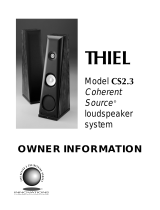 Thiel Audio Products CS2.3 User manual
Thiel Audio Products CS2.3 User manual
-
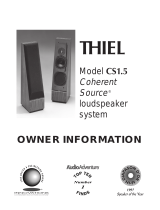 Thiel Audio Products CS.5 User manual
Thiel Audio Products CS.5 User manual
-
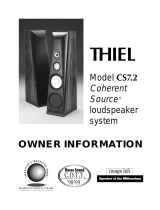 Thiel Audio Products CS7.2 User manual
Thiel Audio Products CS7.2 User manual
-
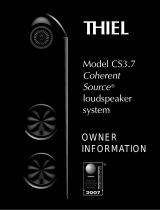 Thiel Audio Products CS3.7 User manual
Thiel Audio Products CS3.7 User manual
-
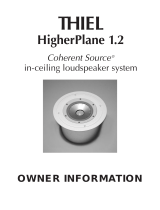 Thiel Audio Products 1.2 Coherent User manual
Thiel Audio Products 1.2 Coherent User manual
-
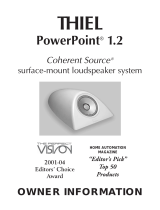 Thiel Audio Products 1.2 User manual
Thiel Audio Products 1.2 User manual
-
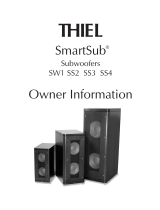 Thiel Audio Products SS4 User manual
Thiel Audio Products SS4 User manual
-
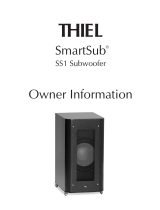 Thiel Audio Products SS1 User manual
Thiel Audio Products SS1 User manual
-
 Thiel Audio Products SS2 User manual
Thiel Audio Products SS2 User manual
-
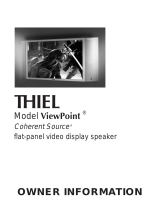 Thiel Audio Products ViewPoint User manual
Thiel Audio Products ViewPoint User manual
Other documents
-
Sandberg 505-67 Datasheet
-
Sandberg 505-69 Datasheet
-
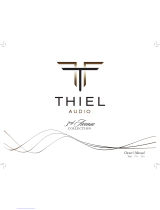 Thiel TC1 Owner's manual
Thiel TC1 Owner's manual
-
Avanity LEXINGTON-V48-LE Installation guide
-
XTZ Divine 100.33 Owner's manual
-
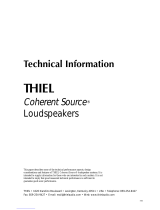 Thiel CS3.6 Datasheet
Thiel CS3.6 Datasheet
-
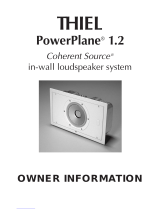 Thiel Coherent Source PowerPlane 1.2 User manual
Thiel Coherent Source PowerPlane 1.2 User manual
-
Pioneer S-IW871LR User manual
-
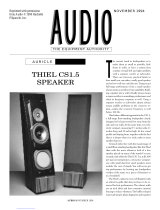 Thiel CS1.5 Quick start guide
Thiel CS1.5 Quick start guide
-
Polk Audio Speaker SR6500 User manual



















